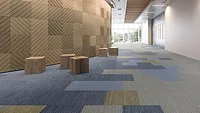Hotel Cevisama: Reimagining Architecture Through Ceramics and Sustainability

Photo: Marcos Soria.

The architectural design of Hotel Cevisama combines bold geometries with ceramic and textile volumes to create a stunning visual impact. Photo: Marcos Soria.

The installation features two distinct hotel rooms that showcase the versatility of ceramics. Photo: Marcos Soria.

At Cevisama 2025, the Hotel Cevisama featured solutions for pool design. Photo: Marcos Soria.
In an ambitious fusion of artistry and sustainability, Hotel Cevisama presented a thoughtful blend of design and sustainability as an architectural installation at Cevisama 2025. Serving as a showcase for European ceramics, the project offers a fresh perspective on hospitality spaces that respond to changing guest expectations while maintaining aesthetic appeal and functionality.
"The architecture of this project must respond to historical evolution and current challenges, creating spaces that go beyond functionality, economy, and aesthetics," the design brief stated. "It should stimulate the senses and embrace the human being in their entirety, both physically and spiritually."
At its core, Hotel Cevisama embraces ceramics as its "secret ingredient" – an invisible yet essential element that infuses every space with historical resonance and craftsmanship. Rooted in the fundamental elements of water, air, earth, and fire, the design creates a bridge between past and future, tradition and innovation.
Spanish architect Héctor Ruiz-Velázquez explains the vision: "It's all about the Mediterranean, the touch of the material, which is very important for us. Going back to earth, the hotel is about organic forms, about materials from the sustainable, from the earth."
The installation features two distinct hotel rooms that showcase ceramics' versatility. "One of them is 100% ceramic, which is a whole room that maintains the temperature, not only sustainable because of the material—it's always sustainable—also because it maintains the temperature without mechanical systems," Ruiz-Velázquez said. "The other one talks about trying to change the room with your own functions, so every person who's staying in that room will can change the forms and have different rooms every time they stay there."
Beyond the rooms, Hotel Cevisama incorporates multifunctional spaces including an outdoor area with a pool, relaxation zones, bars, and a palm grove. These versatile areas are designed to host everything from exhibitions to conferences, creating a vibrant meeting point for industry professionals.
The project's innovative entrance integrates a hall, hotel suites, and reception area, while its architectural design combines bold geometries with ceramic and textile volumes to create a stunning visual impact. The tower features transparency and natural light, establishing a dialogue between materials that creates a sense of lightness and dynamism.
Perhaps most significantly, Hotel Cevisama addresses today's environmental challenges through eco-friendly materials and construction methods. Inspired by Pedro Gadanho's book "Cambio Climáximo!", the project serves as an architectural reflection on how climate change is transforming building practices.
"For us very important in flooring and ceramic is it also unifying spaces," Ruiz-Velázquez said. "We have a material that unifying spaces they are not divided... you have a lot of technology. We have technology here also with nanoparticles. They never have bacteria. It's always clean."
Through this harmonious blending of sensory experience, sustainability, and cutting-edge design, Hotel Cevisama stands as more than just a hotel installation – it represents a statement about architecture's potential to enhance human wellbeing while respecting our environmental responsibilities. As visitors journey through its spectacular spatial sequences, they experienced firsthand how ceramics can create spaces that nourish both body and soul while pointing toward a more sustainable architectural future.
Watch the Video
Looking for a reprint of this article?
From high-res PDFs to custom plaques, order your copy today!



